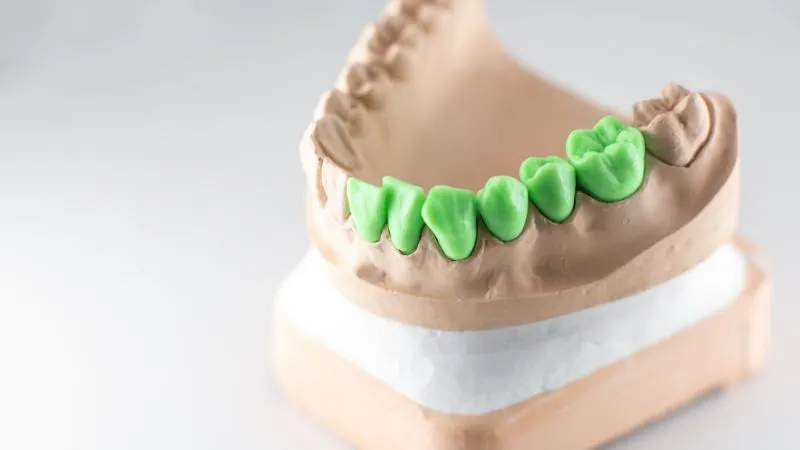The term “green teeth” describes teeth that have a greenish tint. This discoloration, which can range in intensity from a faint tint to a more noticeable shade, is typically brought on by nutritional, environmental, or medical conditions. We’ll discuss the causes of teeth turning green in this post and some potential remedies.
How Do Teeth Turn Green?
Extrinsic staining or intrinsic staining are both ways that teeth can turn green.
Intrinsic staining
Intrinsic coloring occurs deep within the dentin, or inner layer, of a tooth. But when it does, it typically takes place as the tooth develops. A person’s diet lacking certain nutrients or medical disorders may be to blame for the green color.
What are The Main Reasons for Intrinsic Staining?
Green Enamel might occur for some reasons. These consist of:
- Jaundice in newborns
Yellow skin and eyes are signs of jaundice in babies. Excessing bilirubin in the bloodstream is the root cause of this prevalent illness.
A yellow pigment called bilirubin starts formation as red blood cells degrade. Although it is uncommon, too much bilirubin can change the color of developing newborn teeth, causing them to turn green.
Too much bilirubin can turn baby teeth green, and those teeth will stay green until they fall out and adult teeth replace them. It won’t be green on the permanent teeth.
- Persistent jaundice
Jaundice in newborns is referred to as persistent if it persists for more than two to three weeks. Hyperbilirubinemia (excess bilirubin) is frequently the cause of this illness. Green teeth from prolonged jaundice exclusively harm a child’s main teeth, similar to neonatal jaundice.
Cholestatic liver disease inhibits or slows bile flow in the body and may also be to blame in a tiny proportion of instances.
- Incompatibility with Rh (Rh illness)
Your red blood cells’ surface contains a particular protein known as the Rh factor. When a woman is pregnant and has Rh-negative blood but her unborn child has Rh-positive blood, this is known as Rh incompatibility.
The baby’s blood, in this instance, causes the mother’s body to respond as though it were an alien substance: It stimulates antibodies that attack the baby’s red blood cells.
- ABO incompatibility
When a pregnant mother has type O blood but her unborn child has type A or B blood, it happens. Hyperbilirubinemia in babies brought on by ABO incompatibility can also result in the development of green primary teeth.
- Sepsis
It is a fatal response to an illness at any age. The release and flow of bile from the liver may be stopped or slowed by sepsis. Cholestasis is the name given to this sepsis consequence. Children with cholestasis may have green primary teeth.
- Hemolytic anemia
Red blood cells are lost more quickly than your bone marrow can make them, which results in hemolytic anemia. Its causes are numerous and varied. These comprise genetic illnesses like sickle cell anemia. Hemolytic anemia can lead to green stains and an accumulation of bilirubin.
- Medication
Some antibiotics, including ciprofloxacin and tetracycline, might cause the baby’s primary teeth or even the child’s secondary teeth to become green.
Extrinsic staining
The tooth’s enamel, or outer layer, gets stained externally. It typically occurs by an accumulation of bacteria or fungi.
Teeth enamel get greenish stains from dark beverages. Teeth can get stained by tobacco and other drugs.
What Are the Reasons for Extrinsic Stains?
Stains from external sources can turn teeth gray, brown, black, yellow, orange, or green. Extrinsic stains may result from:
• Dark foods, such as blueberries
• Dark beverages, such as red wine, soda, grape juice, coffee, and tea
• smoking
• Chromogenic bacteria, which can accumulate on tooth enamel, frequently close to the gum line and result in green stains on teeth.
Extrinsic stains are more likely to occur if you don’t practice appropriate oral hygiene practices, such as cleaning your teeth twice a day.
How to Treat Green Tooths?
• Whitening toothpaste or rinses are among the things to try at home.
• Whitening gels or strips
• Tray bleaching (whitening tray at home containing a peroxide-based gel).
• In permanent stains, High amounts of hydrogen peroxide break during this technique using a dental lamp.
• Veneers Instead of bleaching teeth, veneers cover them. They help cover difficult-to-remove stains.
• By performing a professional cleaning procedure called scaling and polishing, your dentist can eliminate many green stains.
• Home whitening strips can remove particularly challenging stains.
• Regular dental cleanings and good oral hygiene practices can help prevent recurring extrinsic stains.
Conclusion
Except for Dental Implants and Dental plates, you can prevent Green stains by following the above practices. Maintaining proper oral hygiene, dietary choices, and seeking professional dental care are the key steps to keeping green teeth at bay. In this way, you will preserve the pearly white beauty of your teeth.
FAQ’s
- Can poor oral hygiene really turn teeth green?
Yes, poor oral hygiene can contribute to green teeth.
- Are there any health risks associated with green teeth?
Generally, green teeth are more of a cosmetic concern rather than a serious health issue.
- Are there any natural remedies to remove tooth stains?
Some home remedies like baking soda and hydrogen peroxide may help remove surface stains.
- Is it possible for green teeth to go away on their own?
In some cases, minor green discoloration caused by dietary factors might fade over time with improved oral hygiene and dietary adjustments.
- How can I choose the right teeth whitening treatment for green teeth?
It’s best to consult a dentist before choosing a teeth whitening treatment, especially for green teeth.
- Are there any foods that can help prevent green teeth?
Foods that are high in water content, like fruits and vegetables, can help stimulate saliva production.

